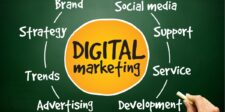Digital marketing has become a cornerstone for building meaningful connections and driving growth in the B2B space. For companies aiming to stand out, it’s not just about reaching other businesses—it’s about delivering value, solving challenges, and fostering partnerships that last.
Mastering the basics of B2B digital marketing is essential for keeping pace in a rapidly evolving market, whether your goal is to enhance your current strategies or pursue fresh opportunities.
Exclusive B2B Marketing Tips You Must Know
Breaking through the noise in B2B marketing often requires more than traditional strategies (which we’ll dive into next). To stand out, you need to leverage tactics that few marketers discuss. Below are actionable, unconventional tips designed to help you unlock new opportunities and redefine your approach to B2B digital marketing.
Tap Into Unlimited Traffic Potential
Many marketers believe there’s a finite pool of traffic for their target audience. However, the truth is that traffic is virtually limitless—you just need to know where to find it.
Start by expanding beyond the platforms everyone uses. While LinkedIn, Google Ads, and email campaigns are staples, there’s enormous untapped potential in lesser-known spaces like Reddit communities, niche industry forums, and even local marketplaces. These channels offer less competition and highly engaged audiences that crave industry-specific insights.
Another strategy is leveraging international markets. Often, B2B companies overlook global opportunities due to perceived barriers like language or cultural differences. Tools like AI translation services and localized advertising can help you reach these untapped markets. Even if your primary market is saturated, expanding your geographic reach can introduce entirely new revenue streams.
Combat ROAS Decline with Content-Powered Retargeting
It’s no secret that digital ad campaigns tend to lose efficiency over time. Once the initial warmer audience is exhausted, your return on ad spend (ROAS) can drop as you begin targeting colder prospects. This doesn’t have to be the end of the line—content-driven retargeting can turn this challenge into an opportunity.
Instead of simply serving ads to colder audiences, create micro-funnels that re-engage them with highly tailored content. This is a focused segment of the marketing funnel that targets a specific step or action in the customer journey rather than covering the entire process from awareness to purchase. For example:
- Develop industry-specific whitepapers that address their pain points.
- Host educational webinars focused on their challenges.
- Offer free tools, calculators, or templates that align with their needs.
This approach can help you build trust and increase conversions over time. It extends the effectiveness of your campaigns and can position your brand as a thought leader in your industry.
The Power of Sequential Messaging in B2B
In B2B marketing, sales cycles often involve multiple decision-makers and extended deliberation periods. This is where sequential messaging can be a game-changer.
It involves guiding your audience through a series of thoughtfully aligned touchpoints across various channels, such as email, LinkedIn, and retargeting ads. Each message builds on the last, creating a cohesive and personalized journey that keeps your brand top-of-mind.
For example, start with an introductory email that highlights a problem your audience is facing, followed by LinkedIn outreach with a case study showcasing your solution. As prospects engage, use retargeting ads to offer them a demo or trial.
The key is anticipating their needs at every stage and providing the exact information they need to move forward. This advanced strategy ensures no touchpoint feels out of place, creating a seamless experience that can significantly boost your conversion rates.
AI-Powered Personalization for B2B
Personalization is an expectation in B2B marketing. However, true personalization goes beyond inserting a prospect’s name in an email. With AI tools, you can elevate your campaigns to an entirely new level of relevance.
Consider using AI-driven platforms to do the following.
- Analyze intent data: Predict which prospects are ready to buy and target them with precise messaging.
- Automate LinkedIn outreach: Tools like LinkedIn Sales Navigator, combined with AI-driven third-party outreach and personalization tools, allow you to craft connection requests and follow-ups tailored to individual prospects.
- Hyper-personalize emails: AI can help you craft emails based on a prospect’s past behavior, company role, and industry trends.
These tools can help you build stronger relationships and close deals faster while saving valuable time.
Exclusive Data Sources for Hyper-Targeting
Accessing exclusive or lesser-known data sources can give you an edge in identifying and targeting high-intent prospects.
Here are some tools and platforms to consider exploring.
- Bombora: This intent-data platform helps you identify companies actively researching topics relevant to your business. Use this data to focus your marketing efforts on prospects already showing buying intent.
- Clearbit (now Breeze Intelligence): Enrich your CRM data with real-time intelligence that gives you a deeper understanding of your prospects’ industries, roles, and pain points.
- LinkedIn Matched Audiences: Upload existing email lists or CRM data to LinkedIn for precise ad targeting. This feature is especially effective for reaching decision-makers with tailored content.
Reverse Engineer Competitor Funnels
Why reinvent the wheel when you can learn from your competitors? Reverse engineering your competitors’ funnels is an advanced tactic that helps you uncover their strategies, messaging, and audience targeting.
Here’s how to get started.
- Analyze their ads: Use tools like Adbeat or SE Ranking to uncover your competitors’ ad campaigns, including their top-performing keywords and creatives.
- Study their landing pages: Look at how they structure their offers, calls-to-action, and lead capture forms. Pay attention to the language they use and how they guide prospects through the page.
- Map out their funnel: Sign up for their email list, download their resources, or request a demo to experience their funnel firsthand. Take note of the steps, timing, and content they use to nurture leads.
You can refine your own strategies and avoid common pitfalls by understanding what’s working for your competitors.
Dark Social: The Invisible Traffic Driver
Dark social refers to traffic that comes from private, untrackable channels such as Slack groups, WhatsApp messages, or email shares. While it’s challenging to measure, dark social can be a goldmine for B2B marketers who know how to harness it.
To capitalize on dark social, focus on creating shareable, high-value content that naturally sparks conversations in private networks. Examples include the following.
- Industry benchmarks or reports: These are often shared within professional groups and teams.
- Quick-reference tools or templates: Practical resources encourage users to pass them along to colleagues.
- Personalized infographics or visual data: Eye-catching visuals are more likely to be shared in chats or Slack channels.
You can also include subtle tracking mechanisms, like UTM codes, to better understand the impact of these private shares. Additionally, encourage sharing by including CTAs like “Pass this along to your team!” in your content.
Effectively tapping into dark social can provide access to highly engaged audiences that might otherwise remain hidden.
10 Digital Marketing Strategies for B2B
Here are ten effective digital marketing strategies for B2B companies:
1. Content Marketing
With 91% of B2B marketers incorporating content marketing into their strategies[1], it’s clear that developing educational, industry-specific resources is essential for success in this space.
Creating in-depth blog posts, whitepapers, eBooks, and case studies can help address your audience’s challenges while positioning your brand as a trusted thought leader.
Content marketing is also incredibly flexible and scalable, allowing businesses to create reusable assets that can be repurposed across various channels or expanded to meet evolving audience needs.
2. Search Engine Optimization (SEO)
Optimize your website for keywords that resonate with your audience’s pain points. Go beyond essential keywords by focusing on long-tail terms and questions relevant to your industry.
Incorporate technical SEO, like site speed optimization and mobile responsiveness, to ensure your site is easy to navigate. Building backlinks from credible sites within your industry can also boost your authority and improve rankings.
3. Social Media Marketing
LinkedIn is ideal for B2B due to its professional focus, but Twitter and niche platforms like Reddit can also provide value. Use social media to distribute thought leadership content, engage in discussions, and connect with decision-makers.
Participating in LinkedIn Groups or hosting LinkedIn Live sessions can increase visibility and foster direct engagement with a relevant audience.
4. Email Marketing and Automation
Email marketing allows for ongoing engagement and nurturing of potential clients. Use automated email sequences to deliver content based on user behavior or stage in the buying journey.
Divide your email list by criteria such as job title, industry, or past interactions to ensure content is highly relevant and engaging.
Personalization is critical in B2B, making recipients feel valued and understood. Additionally, email marketing is one of the most cost-efficient strategies, enabling you to maintain consistent communication with prospects without the high costs of traditional outreach methods.
5. Pay-Per-Click (PPC) Advertising
Running targeted PPC campaigns on Google Ads, LinkedIn, and Bing can drive high-quality leads. Focus on keywords and audience criteria that align closely with your buyer personas.
For B2B, LinkedIn Ads can be particularly effective, as they allow you to target users by job title, industry, or company size.
Test different ad formats (e.g., text ads, carousel ads) to see which performs best. PPC campaigns also provide clear, measurable ROI by monitoring essential metrics such as cost per lead and conversion rates, ensuring that your budget is spent effectively.
6. Retargeting
Retargeting ads allow you to stay top-of-mind for prospects interested in your brand. Use retargeting to re-engage visitors who browsed vital pages, such as pricing or product pages, but didn’t take action.
Displaying targeted ads across platforms like Google Display Network or LinkedIn can encourage these visitors to return and complete their journey.
7. Webinars and Virtual Events
Hosting webinars or virtual events gives you a platform to share expertise directly with an audience interested in your solutions. Choose topics that resonate with common industry challenges and provide actionable takeaways.
Interactive Q&A sessions, panel discussions, or product demos can also build trust and give potential clients insight into your offerings.
8. Video Marketing
Videos are an effective tool for presenting complex ideas in a visually engaging format. Create explainer videos, product demos, customer success stories, or even behind-the-scenes content.
Videos can be shared across social media, embedded on your website, and included in email marketing campaigns. Using video helps make your brand more relatable and can improve channel engagement.
9. Customer Testimonials and Case Studies
Showcasing real-world success stories through testimonials and detailed case studies builds credibility. Use case studies to highlight specific challenges, your approach, and the measurable results achieved.
Case studies and testimonials can be displayed on your website, in sales presentations, and in marketing emails. They serve as social proof, offering potential clients a glimpse of what they can expect when working with you.
10. Analytics and Performance Tracking
Consistent performance tracking is essential to refining your strategies. Use tools like Google Analytics, LinkedIn Analytics, and your CRM to monitor metrics such as conversion rates, cost per lead, and website traffic.
These tools deliver valuable insights into customer behavior, preferences, and engagement patterns, enabling businesses to better understand their target audience.
This data-driven approach not only optimizes campaigns for maximum ROI but also informs product development and customer experience improvements.
What is B2B Digital Marketing?
B2B digital marketing involves promoting products or services from one business to another. It differs from B2C (business-to-consumer) marketing, where the primary goal is to appeal to individual consumers.
Instead, B2B marketing focuses on providing solutions that address business-specific challenges, often requiring more profound industry knowledge and a more targeted approach to communicate value.
B2B digital marketing centers on helping businesses find solutions that improve operations, streamline processes, or boost productivity.
This approach is particularly valuable for service providers, SaaS companies, consultants, manufacturers, and any business targeting other organizations with complex needs.
In B2B, marketing is data-driven and relationship-focused, emphasizing the unique value propositions that resonate with decision-makers.
Whether it’s a SaaS company offering data management software or a consulting firm improving operational workflows, B2B digital marketing aims to address specific pain points and foster long-term partnerships.
How Does B2B Marketing Differ from B2C Marketing?
B2B (business-to-business) marketing and B2C (business-to-consumer) marketing have distinct goals, messaging, and approaches catering to their specific audiences.
Decision-Making Process
In B2B marketing, the purchasing process is typically more complex, involving multiple decision-makers, such as managers, department heads, or executives.
This results in a longer sales cycle as these stakeholders evaluate the product’s ROI, scalability, and integration with existing systems.
B2C purchases usually involve a single decision-maker, making the process faster and often driven by impulse or personal preference.
Messaging
B2B marketing emphasizes efficiency, value, and return on investment (ROI) to meet specific business needs. The messaging is often technical and focused on how the product or service can solve operational challenges or improve business outcomes.
In B2C, the focus is more on emotional appeal and immediate gratification, often highlighting how the product enhances the consumer’s lifestyle or brings satisfaction, convenience, or enjoyment.
Branding
Branding in B2B marketing is centered around building long-term trust and reliability. Businesses seek solutions that align with their goals and will support their operations sustainably over time.
As a result, B2B brands work to establish authority and foster strong, long-term relationships.
In B2C, branding tends to be more image-focused, prioritizing style, trends, and emotional resonance, often through relatable, memorable, and visually impactful campaigns.
Content Strategy
B2B marketing relies heavily on educational and informative content, such as whitepapers, case studies, industry reports, and webinars.
This content is designed to build authority, showcase expertise, and provide in-depth information that aids business decision-makers in their evaluation.
B2C marketing, however, leans more on visually engaging and shareable content, including social media posts, influencer partnerships, and ad campaigns.
It aims to capture attention quickly and resonate emotionally with the consumer.
Sales and Engagement Tactics
B2B marketing often focuses on relationship-building through direct engagement tactics like personalized emails, networking events, and detailed demos or consultations.
B2C marketing, in contrast, prioritizes reaching as many potential customers as possible through mass media advertising, promotions, and brand storytelling.
The engagement strategies in B2C aim to create immediate interest and drive quick conversions.
Measuring Success in B2B Digital Marketing
Metrics are critical for understanding the effectiveness of your campaigns and making data-driven decisions.
Tracking key performance indicators (KPIs) allows you to pinpoint what’s effective, refine your strategies, and ensure your efforts align with your business objectives.
Key Metrics
Several key performance indicators (KPIs) are critical for evaluating B2B marketing success:
- Lead Quality: Prioritizing evaluating the quality of leads generated, assessing how well they match your ideal customer profile and their potential for conversion.
- Customer Acquisition Cost (CAC): Monitoring CAC helps you understand the cost-effectiveness of your marketing strategies.
- Conversion Rates: Analyze conversion rates at various stages—from website visits to email sign-ups and finally to qualified leads and customers—to gauge the effectiveness of your sales funnel.
- Engagement Metrics: Track engagement levels through metrics like time on site, page views per visit, bounce rates, email open and click-through rates, as well as interactions on social media platforms. These metrics reveal audience interest and involvement with your content.
Tracking Tools
The right tools provide deeper insights and streamline the tracking process:
- Google Analytics: Monitors website traffic, user behavior, and engagement patterns. It lets you see which content draws the most attention and where drop-offs occur.
- CRM Software: A CRM system centralizes lead and customer data, allowing you to track interactions, segment leads, and analyze buyer journey progression. This is invaluable for assessing each campaign’s ROI and effectively nurturing leads.
- LinkedIn Analytics: Ideal for tracking the performance of B2B social media efforts, LinkedIn Analytics provides insights into engagement rates, follower demographics, and audience behavior on a platform where business decision-makers are active.
Overcoming Common B2B Digital Marketing Challenges
The common challenges and their solution in B2B marketing are:
Long Sales Cycles
Due to the complexity of the purchase decisions, B2B transactions typically involve longer sales cycles.
Maintaining consistent engagement with potential clients over an extended period can help keep them interested. Regular updates, educational content, and personalized follow-ups effectively guide prospects through the buying journey.
High Competition
Differentiating your brand is crucial in a competitive B2B landscape. Establishing a unique value proposition and showcasing your expertise can help your business stand out.
To build credibility, focus on providing exceptional service, demonstrating your industry knowledge, and highlighting case studies or client success stories.
Trust and Credibility
B2B buyers are generally more cautious, as their purchases impact their business operations significantly. Social proof—through client testimonials, case studies, and positive reviews—can enhance your brand’s credibility.
Showcasing accurate results and evidence of your effectiveness can make a strong impression on possible clients.
Adapting and Thriving in the Evolving B2B Landscape
As B2B digital marketing continues to evolve, companies must go beyond current best practices to stay competitive and adaptive.
Emerging trends like AI-driven personalization, interactive content, and advanced analytics tools will play increasingly significant roles in creating tailored, efficient, and impactful marketing strategies.
By staying responsive to these advancements and focusing on relationship-building, B2B companies can foster deeper connections with clients and achieve sustainable growth.
Moving forward, businesses that blend innovative tools with proven digital strategies will be best positioned to lead in their industries, maintaining agility and foresight in an ever-changing marketplace.
Reference:
1. https://www.demandsage.com/b2b-marketing-statistics/
Related:
- Unlock the Secrets: Digital Marketing Creatives for Success
- 10 Digital Marketing Trends to Watch Out For
- Top 3 Online Marketing Strategies and How to Use Them

We empower people to succeed through information and essential services. Do you need help with something? Contact Us.
Want a heads-up once a week whenever a new article drops?








Great read! I really enjoyed your perspective and the way you explained things so clearly. Looking forward to more content like this.